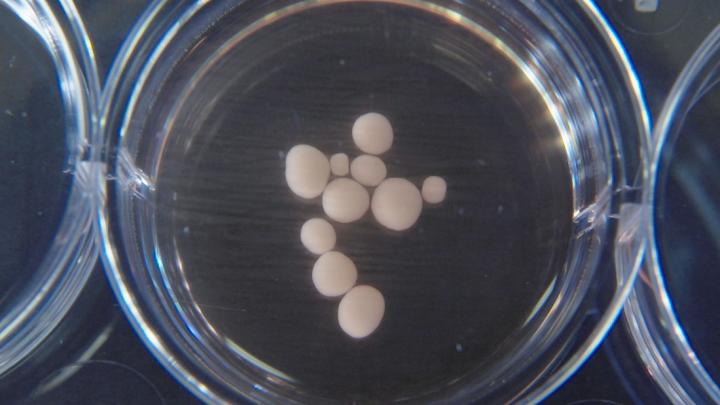近年来,科学家们在器官样物质方面取得了令人印象深刻的进展,器官样物质是类似人体器官的组织块或细胞束。但是,随着技术继续高速发展,伦理考量是否正在迎头赶上?
一组研究人员计划在神经科学学会今天在芝加哥开会讨论基于器官的研究的伦理含义,卫报 报告。他们认为,一些研究有机类的科学家冒着跨越伦理界限的风险,如果他们变得有意识的话,可能会无意中导致他们的生物创造遭受损失——而且一些科学家可能已经通过创造有感觉的组织跨越了这一界限。
过去十年左右,研究人员利用干细胞创建人体器官微型三维模型的能力有了重大提高。这些未分化的细胞可以被诱入不同类型的组织,从而诱入不同类型的器官,从肠到心脏或肾脏。
总的来说,这些并没有造成太多的困境会非常有益生物医学研究——他们回避了人类和动物生物学之间的差异问题,这个问题阻碍了涉及动物试验的传统方法的进步,也回避了这种研究带来的伦理问题。
但是大脑器官的发展——以及在这些器官中检测到大脑活动的研究——引发了一个问题,即它们是否有可能实现意识,如果有,这些实验是否会造成痛苦。
“我们不希望人们在有可能遭受痛苦的地方进行研究,”加州圣地亚哥绿色神经科学实验室主任伊兰·奥哈扬说,他将在今天的会议上发言卫报

10个月大时豌豆大小的大脑器官。
目前存在的大脑器官和小扁豆差不多大,包含(相对较小的)200万到300万个细胞。相比之下,人脑数十亿个细胞。
然而,研究报告称能够检测大脑活动。8月份,研究人员表示,脑电波在10个月的增长过程中持续了两个月,新闻周刊 当时报道称,这是“史无前例的”该小组能够将活动与早产儿的活动进行比较,结论活动等同于出生婴儿的活动受孕后25至39周。
该研究的作者热衷于强调这一点,即这并不意味着它有感知能力,但它确实强调了这一研究领域的快速进展。奥哈扬告诉我卫报,“如果有机生物有感知的可能性,我们就有可能越过那条线。”
他将主张加大检查力度,以降低越线的风险,并主张冻结可能导致器官样变得有意识或涉及将人脑器官样植入物植入其他动物体内的研究(像老鼠一样)。
但这不是科学家第一次提出伦理问题。2018年,一个由生物学家和哲学家组成的小组讨论了涉及人脑替代物研究的问题——人脑替代物是一个涉及离体脑组织和嵌合体以及器官样物质的类别。
这篇文章发表在自然,作者问道:
“如果研究人员能够在实验室创造出看起来可能有意识体验或主观现象状态的脑组织,那么该组织是否应该得到常规给予人类或动物研究对象的任何保护?”
生物科学的伦理、法律和社会影响方面的领先专家妮塔·法拉汉伊在接受阿里斯托斯·乔治乌采访时说:“为了减轻人类大脑损伤带来的巨大痛苦,这项研究能够向前推进是非常重要的。”
“但是一些关于如何在这个领域取得道德进步的问题,包括问一些困难的问题。”
HUMAN MINI-BRAINS CREATED IN LAB MAY BECOME SENTIENT AND ABLE TO FEEL PAIN, SCIENTISTS WARN
In recent years, scientists have made impressive headway with organoids—clumps of tissue or bundles of cells that resemble a miniature version of a human organ. But as the technology continues to progress at rapid speeds, are the ethical considerations playing catch up?
A group of researchers is scheduled to speak at the Society for Neuroscience meeting in Chicago today to discuss the ethical implications of organoid-based research, The Guardian reports. They argue that some scientists working with organoids risk crossing ethical lines and could unwittingly cause their biological creations to suffer, were they to become conscious—and that some may have already crossed that line by creating sentient tissue.
The last decade or so has seen major improvements in researchers' abilities to create mini 3D models of human organs using stem cells. These undifferentiated cells can be cajoled into different types of tissue and thus different types of organ, from the intestine to the heart or kidney.
By and large, these don't pose too much of a dilemma and can be hugely beneficial to biomedical research—they sidestep the problem of differences between human and animal biology that hamper progress with traditional methods that involve animal testing, as well as the ethical questions that come with such research.
But the development of brain organoids—and studies that have detected brain activity in these organoids—raises questions over whether it is possible for them to achieve consciousness and, if it is, whether these experiments could cause suffering.
"We don't want people doing research where there is potential for something to suffer," Elan Ohayon, the director of the Green Neuroscience Laboratory in San Diego, California, who will be talking at the conference today, told The Guardian

Pea-size brain organoids at 10 months old.
The brain organoids that exist as of right now are roughly the same size as a lentil and contain (a relatively tiny) 2 to 3 million cells. The human brain, in contrast, has billions of cells.
However, studies have reported being able to detect brain activity. In August, researchers said brain waves were being produced two months into a 10-month growing process—which, Newsweek reported at the time, was described as 'unprecedented.' The team was able to compare the activity to that seen in premature babies, concluding activity was equivalent to that seen in babies born 25 to 39 weeks after conception.
The study's authors were keen to emphasize the point that it does not mean it was sentient but it does highlight how fast-moving progress in this field of research has become. Ohayon told The Guardian, "If there's even a possibility of the organoid being sentient, we could be crossing that line."
He will be arguing for greater checks to reduce the risk of crossing the line and for freezing research that risks organoids becoming conscious or involves implanting human brain organoid implants into other animals (like mice).
But it is not the first time scientists have raised the ethics question. In 2018, a group including biologists and philosophers discussed the problems around research involving human brain surrogates—a category that involves ex vivo brain tissue and chimeras, as well as organoids.
In the article, published in Nature, the authors asked:
"If researchers could create brain tissue in the laboratory that might appear to have conscious experiences or subjective phenomenal states, would that tissue deserve any of the protections routinely given to human or animal research subjects?"
"It's incredibly important that the research be able to go forward in order to alleviate a tremendous amount of human suffering that arises from injury to the human brain," Nita A. Farahany, a leading expert on the ethical, legal and social implications of biosciences, told Aristos Georgiou at .
"But some of the questions about how to ethically make progress in this area, include asking some difficult questions."






